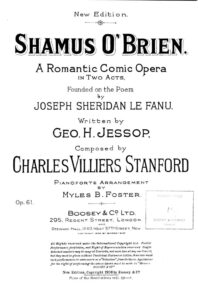A Note from the Chairman
Stanford’s most successful opera, Shamus O’Brien,(Shamus) opened at London’s Opera Comique Theater on March 2nd, 1896 and had a run of eighty-two London performances. Gustav Holst played in the orchestra as first trombone. It then went on an extensive provincial tour in the UK starting in the autumn of 1896, a run in New York and a subsequent tour of the US (including two weeks of performances in Chicago), in early 1897. Later in 1897 the tour continued through Britain. Stanford conducted the first two performances and then Henry Wood conducted the remainder of the initial London run with Granville Bantock, directing most of the provincial tour. The opera was subsequently successfully performed in Australia and Germany.
Stanford banned the production of Shamus in 1912 because of the pollical situation in Ireland. This self-imposed ban only ended on Stanford’s death in 1924 and there was subsequently a production of the opera in Ireland later that year. The BBC broadcast Shamus in 1930, and the Irish RTE broadcasting company made a highly edited studio recording during the 1960s, which may still be heard on You Tube. This contains approximately half of the original music and no dialogue.
It was, therefore, a very special experience to sit in on the recent recording sessions for Shamus at the Silver Cloud Studio in Glasgow on January 31st and February 1st and 2nd of this year. Listening to this music it was easy to see why Shamus was such a success during its initial run. The music is lively and tuneful, there is plenty of action, strong characterization and a great deal of drama. David Parry expertly conducted the Orchestra of Scottish Opera with a strong cast of young soloists and chorus in this first fully professional recording of any Stanford opera. Dr. Valerie Langfield of Retrospect Opera had prepared the performance score for this recording from several sources, including a copy of Stanford’s full manuscript score. Retrospect has recorded all one hundred minutes of the music and the fifty minutes of dialogue for this project.
The first recording of music from Shamus took place in 1901 when Joseph O’Mara, who had created the role of Mike Murphy in the original production, recorded “ Ochone! When I used to be young. “ Stanford himself subsequently recorded the Overture to Shamus for HMV on November 6th, 1916.
Douglas Bostock recorded the Overture from Shamus with the Royal Liverpool Philharmonic Orchestra on August 5th, 2000. This was released on the Classico Label (Classico 1301.) SOMM recorded four of the men’s songs from Shamus with Roddy Williams and James Way, on June 26th, 2019, accompanied by Andrew West. And on January 28th 2023, Sharon Carty recorded “ Where is the man?” and “ A grave yawns cold” from Shamus accompanied by Finghin Collins, for a forthcoming CD of Stanford’s Irish Song Cycles on Somm.
Retrospect Opera plans to release this new recording of Shamus early in 2024 as part of the events to mark the one hundredth anniversary of Stanford’s death in 1924. The booklet for the two CD set will include the full libretto of the opera and essays on Stanford and Shamus O’Brien by Stanford scholars Professor Jeremy Dibble, Dr. Paul Rodmell and Dr. Adele Commins.
The Stanford Society and many of our members have provided significant financial support for this recording. We hope that its release will contribute to continuing the recent uptick of interest in Stanford’s operas. We look forward to new productions of Shamus and further professional recordings of other Stanford operas in the future.
